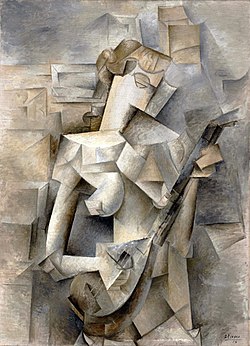
Back Kubisme Afrikaans Kubismus ALS تكعيبية (فن) Arabic التكعيبيه ARZ Cubismu AST Kubizm Azerbaijani Kubismo BCL Кубізм Byelorussian Кубізм BE-X-OLD Кубизъм Bulgarian

Cubism is an early-20th-century avant-garde art movement begun in Paris that revolutionized painting and the visual arts, and influenced artistic innovations in music, ballet, literature, and architecture. Cubist subjects are analyzed, broken up, and reassembled in an abstract form—instead of depicting objects from a single perspective, the artist depicts the subject from multiple perspectives to represent the subject in a greater context.[1] Cubism has been considered the most influential art movement of the 20th century.[2][3] The term cubism is broadly associated with a variety of artworks produced in Paris (Montmartre and Montparnasse) or near Paris (Puteaux) during the 1910s and throughout the 1920s.
The movement was pioneered in partnership by Pablo Picasso and Georges Braque, and joined by Jean Metzinger, Albert Gleizes, Robert Delaunay, Henri Le Fauconnier, Juan Gris, and Fernand Léger.[4] One primary influence that led to Cubism was the representation of three-dimensional form in the late works of Paul Cézanne.[2] A retrospective of Cézanne's paintings was held at the Salon d'Automne of 1904, current works were displayed at the 1905 and 1906 Salon d'Automne, followed by two commemorative retrospectives after his death in 1907.[5]
In France, offshoots of Cubism developed, including Orphism, abstract art and later Purism.[6][7] The impact of Cubism was far-reaching and wide-ranging in the arts and in popular culture. Cubism introduced collage as a modern art form. In France and other countries Futurism, Suprematism, Dada, Constructivism, De Stijl and Art Deco developed in response to Cubism.[4] Early Futurist paintings hold in common with Cubism the fusing of the past and the present, the representation of different views of the subject pictured at the same time or successively, also called multiple perspective, simultaneity or multiplicity,[8] while Constructivism was influenced by Picasso's technique of constructing sculpture from separate elements.[9] Other common threads between these disparate movements include the faceting or simplification of geometric forms, and the association of mechanization and modern life.
- ^ Jean Metzinger, Note sur la peinture, Pan (Paris), October–November 1910
- ^ a b "The Collection | MoMA". The Museum of Modern Art. Archived from the original on August 13, 2014.
- ^ Cubism: The Leonard A. Lauder Collection, The Metropolitan Museum of Art, New York, 2014 Archived 2015-05-17 at the Wayback Machine
- ^ a b "The Collection | MoMA". The Museum of Modern Art. Archived from the original on June 13, 2014.
- ^ Joann Moser, Jean Metzinger in Retrospect, Pre-Cubist works, 1904–1909, The University of Iowa Museum of Art, J. Paul Getty Trust, University of Washington Press 1985, pp. 34–42
- ^ "The Collection | MoMA". The Museum of Modern Art.
- ^ Magdalena Dabrowski, Geometric Abstraction, Heilbrunn Timeline of Art History, The Metropolitan Museum of Art, New York, 2000
- ^ "The Collection | MoMA". The Museum of Modern Art. Archived from the original on July 2, 2015.
- ^ "The Collection | MoMA". The Museum of Modern Art. Archived from the original on October 24, 2008.